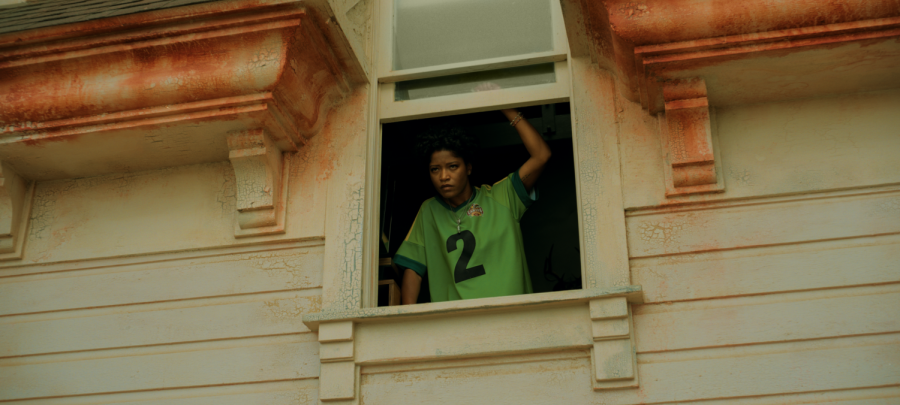Jordan Peele’s ‘Nope’ is the must-see blockbuster of the summer
Keke Palmer as Emerald Haywood in Nope, written, produced and directed by Jordan Peele.
July 20, 2022
This article is spoiler-free.
Toss every preconception about Jordan Peele’s “Nope” completely out of the window. While the official trailer does not prepare viewers for the bizarre and otherworldly storyline and plot, Stevie Wonder’s featured 1962 “Fingertips” recording hints at the film’s jittery mood and excites audiences to witness the spectacle on the silver screen.
“Nope,” set to release July 22, introduces a downpour of sci-fi propelled by horror and mystery into Jordan Peele’s Monkeypaw Productions. The film is set at Hollywood’s Haywood Ranch and follows horse trainer siblings Emerald Haywood (Keke Palmer) and OJ Haywood (Daniel Kaluuya) joined by their nearby neighbor Ricky Park (Steven Yeun) as they try to catch an inexplicable gliding object disrupting the electricity around them.
The film is unlike any sci-fi, horror, mystery or Western themed movie to date. With evident influences from “Jaws” and “Close Encounters of the Third Kind,” Peele tastefully depicts different reactions to all-consuming terror. Peele emulates the iconic “You’re gonna need a bigger boat” scene from “Jaws” with Emerald, OJ and Angel (Brandon Perea), Fry’s electronics technician, upon realizing their battery-powered digital cameras are no match for what’s above. This reference challenges the trio’s and audiences’ typical approach to capturing a UFO on video, proving it is a bigger challenge to get the undeniable “Oprah shot.”
Organized by reflective title cards, each narrative section provides compelling, emotive stills of each character’s emotions and anxious thoughts about their own independent situations. OJ, who spends most of the duration of the film on a horse, embodying the legacy of Black men riding on horses in Hollywood, portrays a restrained but hard-headed grieving son. Conversely, Emerald provides the perfect partner to OJ, showcasing a charismatic, unshaken and confident persona. While a dynamic tag team in the movie, Palmer outshines Kaluuya with her quick-witted remarks and raw reactions.
Additionally, each character uniquely garners humor to ease the suspense with intentional pop culture references and comedic one-liners, sure to leave viewers warmly laughing at the characters’ responses to the chaos unfolding around them. The natural and clear delivery of this comedic dialogue perfectly assists the narrative and explains the deeper context within mini subplots buried in the title cards.
Similar to prior Peele films, “Nope” requires a close eye and connective thoughts behind the sequencing and naming of each title card. He masterfully explores topics such as serving as a fierce protector of your family or beliefs, family legacies, sibling love and the obsession of documentary exploitation within the Hollywood industry are some themes audiences can pick up after their first viewing. However, much like the rest of his work, it will most likely take more than one viewing to even scratch the surface of the messaging and themes Peele curates in the just over two-hour runtime.
Finally, since comparing “Nope” to “Get Out” and “Us” is a natural discussion, although comparing the three films is like comparing apples to oranges to pears, “Nope” differs from the previous two most notably with its soundtrack. “Get Out” featured a chilling version of Childish Gambino’s “Redbone,” and “Us” remixed a haunting version of Luniz and Michael Marshall’s “Got 5 on It.” However, this new blockbuster lacks a catchy summer pop hit, instead warping and fading a snazzy soulful blues horn chorus, mirroring the Haywood ranch house’s loss of electricity. While this is an artistic musical addition, the overall soundtrack does not stand out among its predecessors within Peele’s films.
After seeing “Nope,” audiences will probably not want to stare at the clouds for too long for the following couple of days, but will still see this film at least two more times before it leaves theaters. Until then, as Keke Palmer says, “You’ll see soon enough.”
4 1/2 bloody monkey paws out of 5











